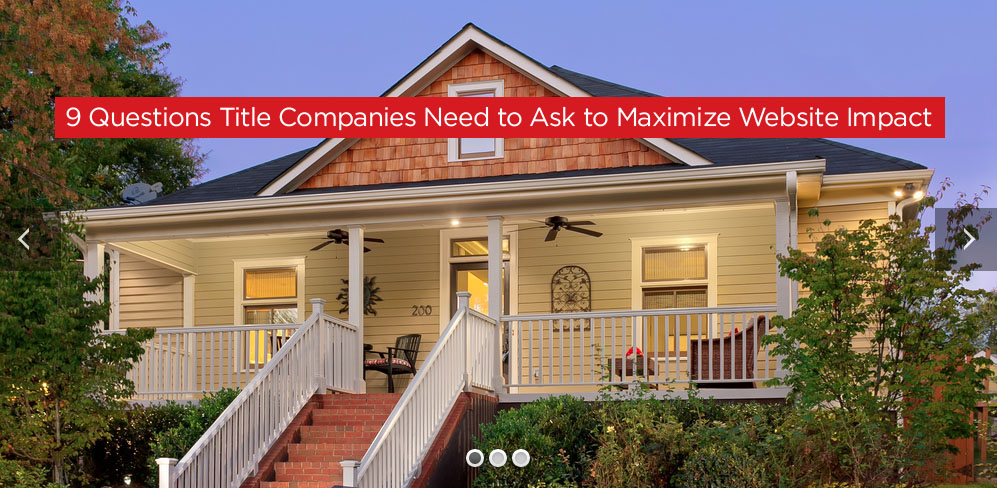
It can be hard to determine when a website is due for a redesign. You’ve used it for years and it has served you well. But what seems to you as modern, welcoming, and helpful can seem to potential customers as outdated and hard to use. To determine if your title insurance website has gotten to that point, ask yourself these questions.
Is the site responsive?
This has to be the first question when evaluating your site. Mobile isn’t a trend—it’s a necessity. Google threw down the gauntlet in April 2015 when it declared that it would be giving significant advantage in rank to mobile-friendly sites. Google’s preferred type of mobile-friendliness is responsive, as opposed to a separate mobile site or mobile app. Responsive design lets the content of the site adjust to the device that’s being used. A majority of online searches happen on mobile, whether smartphones or tablets, and not having a responsive site will result in fewer site visits.
Has the Flash on the site been removed?
In the recent past, using Flash players to display videos or play music was popular. With the rise in mobile, and the inability for mobile devices to be Flash-compatible, Flash is going by the wayside. There are other ways to accomplish the same effects. Website plugins can display slideshows and rotating sliders, while videos and other media can be directly embedded.
Are we getting new visitors to the site?
To answer this question, you’ll need to have an analytics platform installed on your website. The most popular is Google Analytics, which is free. From there, you can look at the number of new visitors compared to returning visitors. Has the number of new visitors been consistent or has it dropped off? What has it been since April? Significant changes in visitors could mean your website has started to work against you.
Is the site easy to use?
Another part of analytics is users flow, or the journey a visitor takes through your site. This can help you see if your site is simple to use. Do most people follow a logical path, or do they skip around? Are the exit points random pages? Seeing how visitors travel through your site can help you improve the user experience by helping them through the site with changes to design and/or content.
Are resources easily accessible?
The best title insurance company websites have resources for their customers and potential clients. You should have pages outlining your services, and could include a mortgage calculator, a rate sheet, important forms, among other resources. Resources should be readily available from the navigation menu, and shouldn’t require the users to dig through the site to find what they’re looking for.
Can orders be placed on the site?
With the increasing popularity of mobile, consumers are accustomed to filling out forms online for everything from food to clothes to bills. Making orders available online saves time for the customer, and allows them to place an order when it is convenient for them. Once orders are placed, they are stored in a database and can be emailed to the correct staff member for review. It is also possible to integrate an order-entry step to save on the man-hours of data entry.
Can we edit the content on our own site?
The ability to change or add pages should be a readily available option for you. You shouldn’t need to contact an IT department or agency to edit content on your site. Website platforms like WordPress have easy-to-use systems that can also integrate plugins and order systems. If you can’t edit your own site, that’s a problem. If you don’t want to, that’s a different story. Some companies find it easier to call their agency to change the site, but you should always have the option.
Do we have a blog?
Blogs help you to continue to get new visitors to your site because through the posts you can provide information to potential customers, while also becoming a thought leader and expert in the field to existing customers. The posts also work long after they’re published because they can still lead prospects back to your site.
Do we know where we rank?
Rank is the position where your site comes up on search engine results pages. The rank of a website is a mixture of complicated algorithmic components, but there are still some ways you can help increase your site’s rank. Keep updating the site with valuable content and relevant keywords, and be sure to use the most updated search engine optimization tips. If your site hasn’t been touched in a while, it might not be optimized for current algorithms.
A title company’s strategic plan should always include an up-to-date website. Keeping a website current doesn’t mean redesigning every year, but understanding the needs of your customer in the digital space is crucial. If the answers to the above questions are “no”, then it’s time to make a website that matters to your customer base and increase the impact your digital presence makes.
Sparkfactor has a proven track record of creating easy-to-navigate title company websites, some of which include Fidelity Land Title, Acquest Title Services, Dane County Title, and Frontier Land Title, as well as a website template available exclusively to Fidelity National Title Group associates. Find out more about how your title company’s website can maximize its impact.
{{cta(‘77320f7e-dd23-4481-8bb5-2f81ab5e7c45’)}}
